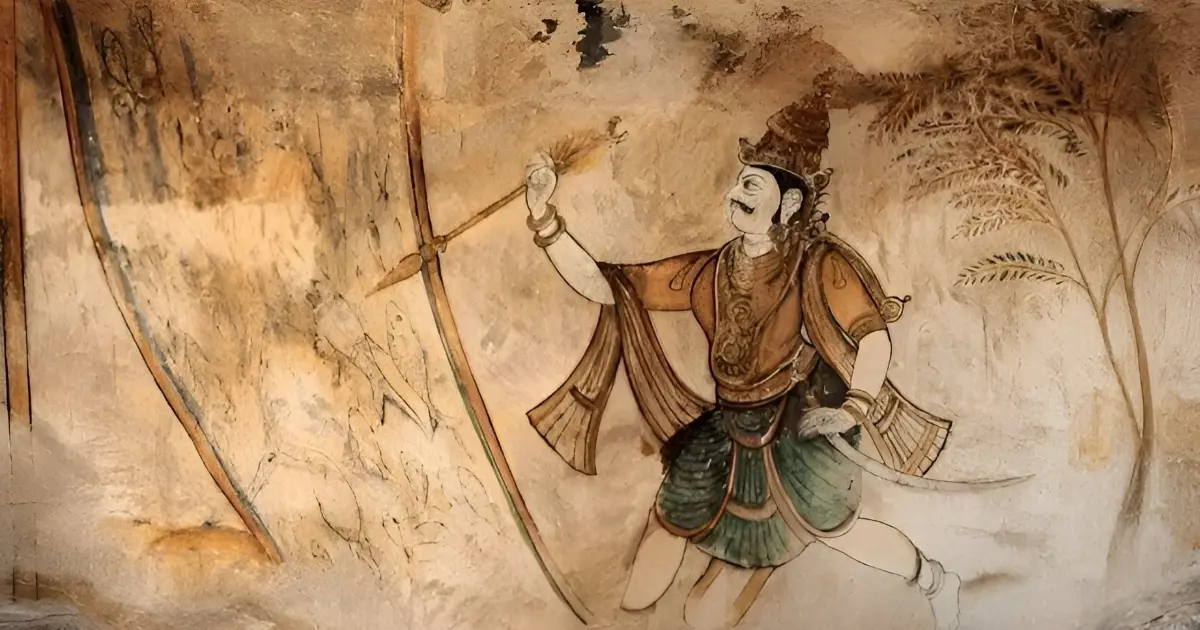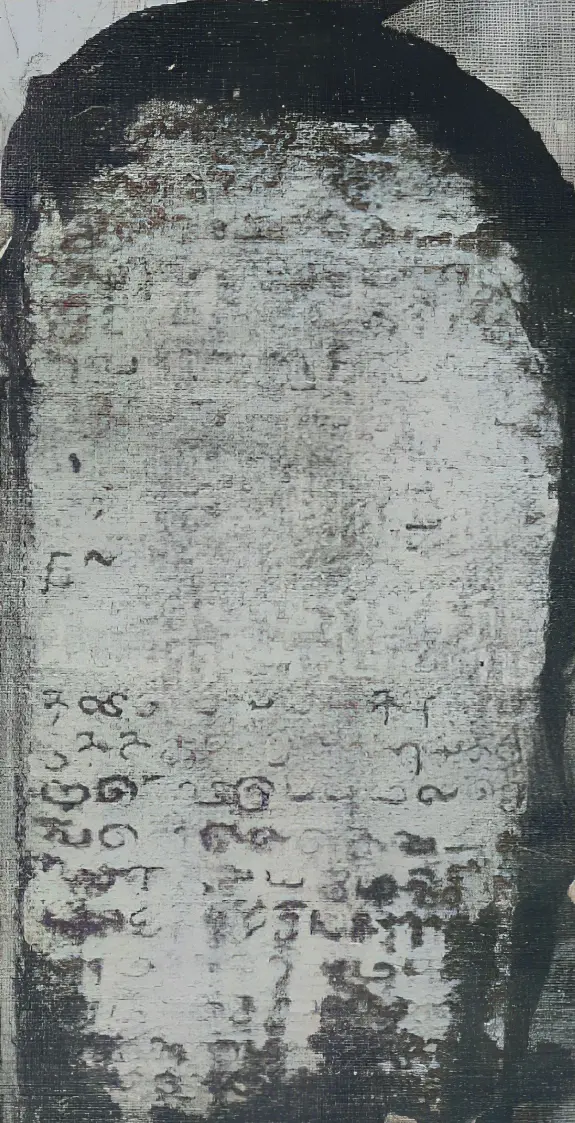Articles > Published Studies > Valangai Uyyakondar: A Forgotten Chola Clan Whose Heritage and History Connect to the Nadars of Today.
Valangai Uyyakondar: A Forgotten Chola Clan Whose Heritage and History Connect to the Nadars of Today.
Published Studies
Featured
April 14, 2025
Introduction
The Valangai Uyyakondars (pronounced as Valaṅkai Uyyakoṇṭār) are an ancient Nadar subsect [note 1]. Archaeologists have discovered many ancient historical documents that are relevant to the Uyyakondars. These historical documents are vital for understanding the history of the Nadars. The purpose of this article is to elaborate on some of the important historical documents of the Valangai Uyyakondars and their familial ties to the Chola dynasty. This article is based on the research contributions of Mr. S. D. Nellai Nedumaran, Mr. S. Ramachandran, and Dr. A. Thasarathan.

A mural of Emperor Raja Raja Cholan I
Uyyakonda Valanadu
During Emperor Raja Raja Cholan I’s reign, the Chola country was divided into several provinces, each named after his imperial titles. These unique titles may have either been epithets of the Cholan emperor's clan or sobriquets of the Cholan emperor. The Uyyakonda Valanadu was one such province, named after the title Uyyakondar, which was among the many titles attributed to the first Raja Raja Cholan.
An ancient inscription from the period of Sundara Pandian mentions an Akalanka Nadalvar, ruler of Uyyakondar Valanadu, who had the privilege of owning Cholan crown lands. This affirms that Uyyakonda Valanadu was ruled by lords of Cholan descent. The inscription also bolsters Akalanka Nadalvar's reputation as a formidable warrior, stating that he was known to win battles with his bare hands. Saint Yenathi Nathar, a member of the Sanror clan, was born in Eyinanur [note 2], a part of Uyyakonda Valanadu.
The panegyric of the first Raja Raja Cholan reveals that the ruler of Uyyakonda Valanadu, known as Ambar Nadan, hailed from a warrior clan. Various Sanror historical documents confirm that the title Nadalvar was one of the titles used by the Sanrors, the ancestors of the Nadars [note 3]. Renowned archaeologist S. Ramachandran proposes that the title Nadalvar gradually, over the course of time, became Nadar. Similarly, the title Nadan has been exclusively associated with the Nadar community since ancient times (refer to the reference pages via the link below). These pieces of evidence infer the link between the rulers of Uyyakonda Valanadu and the Sanrors.
11th-century Kalugumalai inscription about the Uyyakondars
The 11th-century (1043-1044 AD) Kalugumalai inscription records a Uyyakondar from Pavitramānikkapuram who had the privilege to own half the land in the region and the authority to donate the rest to the temple. The inscription further reveals that this Uyyakondar landowner was of kingly descent.
11th-century Singalandapuram inscription about the Uyyakondars
An 11th-century (approximately 1080 AD - 1100 AD) inscription from Singalandapuram, Perambalur district, mentions a Veerakodi Vellalar of that time who was honoured for his military services by the Valangai Uyyakondars. The inscription also makes a mention of the title Sengol Devi, which means Sceptre Goddess in Tamil.

11th-century Singalandapuram Uyyakondar inscription
During the Chola era, the sceptre or Sengol (pronounced as Ceṅkōl) was used during coronation ceremonies. The sceptre was usually given to the new ruler to symbolise the transfer of power from one ruler to another. In short, the sceptre was a symbol of power. The 17th-century Sanror ballad Valangai Malai affirms that the title Sengol Devi was one of the Uyyakondar titles. According to archaeologist S. Ramachandran, the literal meaning of the Uyyakondar title Sengol Devi implies that the Uyyakondars wielded the authoritative power of royal family members.
13th-century inscription about the Uyyakondars
A 13th-century (1227 AD) inscription at Ponnur, Pudukkottai district, records the Valangai Uyyakondars endowing properties to the temples. The inscription further states that the Uyyakondars were also responsible for the construction of temple mandapas [note 4].
Inscriptions about Uyyakondars from the period of Nayak rulers
The 17th-century (1662 AD) Vikramasingapuram inscription records that Vadamalaiyappa Pillai, representative of the Nayak King, honoured a Valangai Uyyakondar by the name of Sivanthi Nadan by granting him special tax privileges. It further states that Vadamalaiyappa Pillai allowed this Uyyakondar to retain the title Perumparru (pronounced as Perumpaṟṟu). The term Perumparru means lands owned by warriors in ancient Tamil. In the southern districts of Tamil Nadu, there are many villages, named Perumparru, with predominant Nadar populations. Nevertheless, the inscription further indicates the Uyyakondars' demise as royalty during Nayak rule, revealing that Sivanthi Nadan struggled under heavy taxation and was compelled to appeal to the Nayak representative for tax relief.
17th-century Sanror historical documents
Archaeologists have recently discovered many 17th-century Sanror historical documents, including panegyric poems about the ancient Sanror community. Among these discoveries, the 17th-century ballad (or Villupattu) Valangai Malai is considered the most significant. Valangai Malai contains intricate historical details about the Valangai Uyyakondars. For instance, Valangai Malai records that the title Amaravati Thalaivar, which translates to leader of Amaravati, was one of the titles attributed to the Uyyakondars. This title, Amaravati Thalaivar, can be consistently found in all ancient Uyyakondar historical documents.
Valangai Malai further affirms that the title Booventhiya Cholan was bestowed upon the Valangai Uyyakondars for their military services. It also indicates that the Chera and Chola kings were descendants of the Sanror clan. The 16th-century historical book, Sivalamaran Kathai, confirms that the Uyyakondars hailed from the Surya kulam, or Solar race. It's a well-known fact that the Cholas, like the Uyyakondars, hailed from the Surya kulam or Solar race. With these pieces of evidence, it is safe to conclude that the Uyyakondars and Cholas were related to each other.
According to a 16th-century historical book called Sivalamaran Kathai, the Uyyakondars hailed from the Surya kulam, or Solar race. It's a well-known fact that the Cholas, like the Uyyakondars, hailed from the Surya kulam or Solar race. With these pieces of evidence, it is safe to conclude that the Uyyakondars and Cholas were related to each other.
18th-century Kodungallur copper plate document
The 18th-century Kodungallur copper plate document records that the Valangai Uyyakondars of this period (1766 AD) were known as Sanrors or Nadars. This evidently proves that the Nadars and Uyyakondars are of the same race.
Sanrors are the ancestors of the Nadars
Ancient Sanror palm leaf manuscripts and copper plate documents prove that the Sanrors are the ancestors of the Nadar community. For instance, the 17th-century Karumapuram copper plate refers to the Sanrors as Saana Kulam, meaning Saana clan in Tamil, and describes a member of the clan as Saana Kula Dheeran, which loosely translates to valiant hero of the Saana clan. The term Saana is the adjectival form of Sanar in Tamil and thus corroborates that the Sanrors are, in fact, the Sanars (Nadars)—as Saana serves as an epithet specifically referring to the Sanrors.
Conclusion
These ancient historical documents corroborate the Uyyakondars' familial ties with the Cholan dynasty, their significance as a military nobility in ancient Tamil society, and their eventual decline as royalty during Nayak rule. The evidence from inscriptions and Sanror historical documents confirm that the Valangai Uyyakondars, were actually Sanrors—the ancestors of the contemporary Nadar community—establishing the Uyyakondars as a vital part of Nadar history.
Notes
- The term Valangai literally means right hand in Tamil. The title Valangai was used by the right-hand castes. Right-hand caste members were, in ancient times, regarded as war veterans. The Nadars are a right-hand caste.
- Yenathi Nathar was one of the 63 Shaivite Nayanmars. He was an Eela Sanrar, an ancient Sanror subsect. The traditional occupation of Yenathi Nathar's clan, according to the 12th-century book Periya Puranam, was instructing the art of war to soldiers.
- The terms Sanrar, Sanravar and Sanar are variants of the term Sanror. This is because of a common linguistic feature in Tamil. For instance, the word Kaṉṟu (meaning "calf") and its variant Kaṇṇu are essentially the same word with different pronunciations. The Nadars today were previously known as Sanars or Shanars.
- Mandapas are pavilions, inside Hindu temples, used for rituals.
See Also
- From oblivion to light: Reconstructing Nadar community's history through recently discovered ancient documents.
- Connecting the Dots: Understanding the Relationship Between the Noble Sanrors and the Nadar Community.
- Ezhunutruvars: Descendants of the Muvendar Lineage, Renowned for Their Role in Governance and Military Service.
- Yenathi: The Clan of the Saivite warrior-saint Yenathi Nathar that traditionally trained the soldiers of the king's army.
- The Velirs and the Sanrors: Comprehending Their Shared Customs, Heritage, and Royal Legacy as Historically Related Clans.
References
- S. D. Nellai Nedumaran. "Valangai Uyyakondar." Journal of the Epigraphical Society of India, vol. 23, 1997, pp. 131–138.
- S. Ramachandran. Valaṅkai Mālaiyum Cāṉṟōr Camūkac Ceppēṭukaḷum. Tamil Archaeological Book. International Institute of Tamil Studies, Government of Tamil Nadu, 2004.
- V. Nagam Aiya. The Travancore State Manual. Vol. 2, Travancore Government Press, 1906.
- A. Thasarathan and A. Ganesan. "Māṉavīra Vaḷa Nāṭṭuk Kalveṭṭukaḷ." Tamiḻil Āvaṇaṅkaḷ, edited by A. Thasarathan, T. Mahalakshmi, S. Nirmala Devi, and T. Bhuminaganathan. Tamil Archaeological Book. International Institute of Tamil Studies, Government of Tamil Nadu, 2001, pp. 52-59.
- S. D. Nellai Nedumaran. "Koṅkunāṭṭu Camutāya Āvaṇaṅkaḷ." Tamiḻil Āvaṇaṅkaḷ, edited by A. Thasarathan, T. Mahalakshmi, S. Nirmala Devi, and T. Bhuminaganathan. Tamil Archaeological Book. International Institute of Tamil Studies, Government of Tamil Nadu, 2001, pp. 95-105.
- K. R. A. Narasiah. "How the British Took Advantage of a Complex Caste System." The Times of India, 14 Aug 2018.
- Hardgrave, Robert L., Jr. The Nadars of Tamilnad. University of California Press, 1969.
- "Tamil Nadu's Historic Sceptre 'Sengol' to Be Placed in New Parliament Building." Outlook, 23 May 2023.